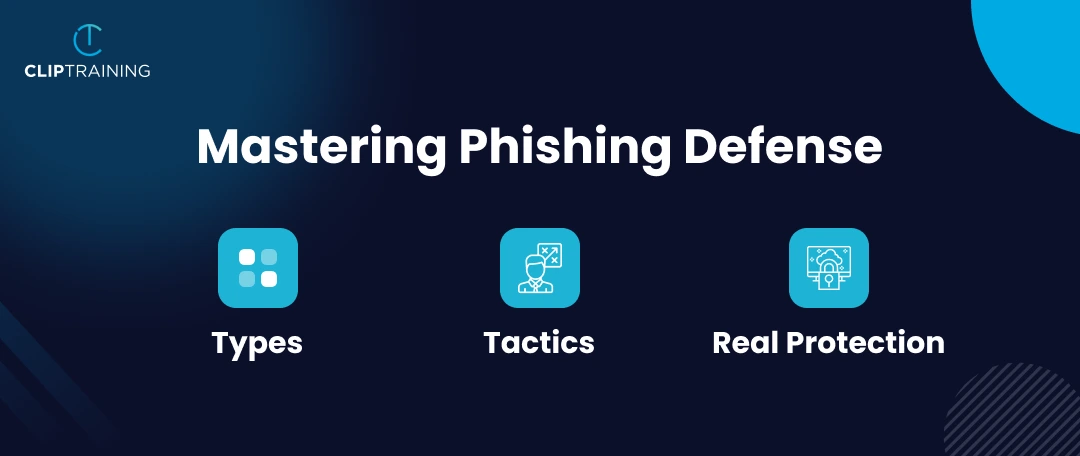Phishing attacks have become one of the most widespread and preferred cybercrime tactics today. Starting from messages an employee receives in their email inbox to an entire organization’s network, they can be susceptible to such attacks, and the more concerning factor is that they come in different forms. Mastering phishing defense starts with understanding how these attacks work — because phishing can even catch the most cautious people off guard by using methods and tactics that seem legitimate on the surface. In our blog, we will dive into the different forms of phishing attacks and the different effective strategies that can be used to defend against them. Phishing is the most common form of cyber crime, with an estimated 3.4 billion spam emails sent every day.
What is Phishing?
Phishing is a type of cyber attack which mainly involves a person or organization’s sensitive information being compromised. The sensitive information tends to include confidential data such as credit card information, usernames and passwords. Such attacks are often carried out by creating trustworthy entities such as a social media site or bank.
The attackers in this scenario usually send emails or messages or create websites that look identical to legitimate ones to lure the target in a false sense of security that ends up inviting their victims to click on malicious links that download harmful software and attachments.
Phishing attacks are one of the oldest and effective forms of cybercrimes around the world that have caused some of the biggest financial losses and data breaches. One of the main reasons why phishing attacks are so dangerous is because if they are well-crafted, then even the most sophisticated technological defenses can fall prey to them in the absence of proper protection.
Different Types of Phishing Attacks
Mastering phishing defense requires understanding the different types of phishing attacks. Each type of phishing attack deploys a certain strategy that aims to entice and deceive the user in multiple ways, and knowing how to recognize such strategies will be the first step in preventing a data breach.
Here are the 5 main types of phishing attacks that everyone should beware of:
1. Spear Phishing
Spear phishing refers to targeted attacks where the attackers tend to focus on a specific organization or even an individual. To make these attacks appealing to an individual or organization, they are often personalised. This personalization is based on the information that the attackers gather about the person. Which includes the person’s name, job title, recent activities and even family details.
The personalization of such types of attacks makes spear phishing very hard to recognize. It can come in the form of an email from a boss asking to send bank account details for money transfer. Oftentimes, the outcome of these phishing attacks is devastating because they are convincing and seem to be coming from a trusted source.
2. Email Phishing
Email phishing is the most common type of phishing, and the one that most people fall prey to. These attacks involve the attacker sending a fraudulent email that seems to be originating from a legitimate source. The source can be of multiple kinds, such as online retailers, government agencies or even banks.Attackers craft these emails to create a sense of urgency, pressuring the target to click on the link without carefully examining it.
The moment a person clicks on the link, the attacker immediately downloads malware onto their computer or redirects them to a fake website designed to steal their sensitive information.
3. SMS Phishing
SMS phishing, or Smishing, uses text messages to carry out phishing attacks. Like email phishing, attackers send fraudulent messages posing as well-known or reputable organizations to deceive recipients. This message often contains a link that leads to fake websites that steal personal information.
Since smartphone users are increasing by the moment, Smishing is also becoming increasingly popular.
4. Whaling
Whaling is a type of spear phishing that not only has an individual target but rather also targets high-profile individuals. These individuals could be CFOs, CEOs and other company executives. This type of phishing attack has higher stakes because they aim to extract trade secrets, sensitive company data and large sums of money.
Because the stakes are so high, attackers craft these attacks to closely resemble official business communication. They may impersonate trusted vendors or business partners, mimicking branding and mannerisms used within the company to deceive employees.
Whaling attacks pose a serious threat by exploiting the authority of high-profile individuals they target.
According to stats, one whaling attack costs a business an average of $47 million.
5. Voice Phishing
Voice Phishing or Vishing is another similar type to smishing or email phishing. However, the only thing different in this form is that it involves calling an individual by posing as a representative of legitimate organizations. Like the other phishing attacks mentioned above, they aim to convince their victims to reveal their sensitive and personal information on the call.
Vishing attacks can also involve the use of fear tactics, including arrest or account suspension, etc, to create a pressure situation.
6. Clone Phishing
Clone phishing is when the email ID of a reputable and legitimate email that the person has received is identically copied. With the help of this, the attacker can then modify the content of the email to use for their benefit.
In doing so, they will attach malicious links. This type of phishing tricks an individual into clicking on the link because the email is very similar to another trusted email ID in their inbox.
Strategies for Defending Against Phishing
To successfully protect an organization from cybercriminals looking to access sensitive information through phishing attacks requires having effective strategies and programs. Mastering phishing defense is a perfect combination of technical safeguards, proactive behaviours and awareness.
Here is a list of things that a business should do to defend against phishing.
1. Create Awareness About Such Threats
The first and most important step in mastering phishing defense is training your team. Regular awareness sessions help employees recognize threats like suspicious links or fake login pages.
At ClipTraining, we offer phishing awareness training that covers every stage — from spotting scams to handling them the right way. This also includes vishing awareness, so your team doesn’t share sensitive data over the phone.
Our phishing simulations take this a step further. These controlled tests let your team practice spotting phishing attempts without the real-world risk.
2. Multi-Factor Authentication
To make sensitive information more difficult to access and less likely to fall into the wrong hands, multi-factor authentication is an effective strategy. This strategy is one of the best ways to master phishing defense because it requires around two or more forms of authentication from the users to access their accounts. This could be in the form of requiring passwords, one-time codes or even fingerprints.
MFA significantly reduces the chances of cybercriminals gaining unauthorized access to sensitive information because even if they manage to steal a user’s credentials, they won’t be able to access their account and information without passing the second step of authentication.
3. Encourage Use of Anti-Phishing Tools
Another way to master phishing defense is by downloading anti-phishing software and tools that actively scan new emails and websites for malicious activity. Further, they also inform users and caution them against clicking on it.
While awareness in itself is important to help prevent users and employees from falling for phishing attacks, it is also essential to provide them with reliable assistance against potential threats. Bigger organizations can also look into using web filters and firewalls for additional security and blocking access to malicious websites.
4. Check Email Addresses and URLs Carefully
With the help of ClipTraining’s employee training program for mastering phishing defense, businesses can easily learn to spot any inconsistencies in the email addresses and URLS to help alert against potential fraudulent activity. By carefully inspecting the URLs of different websites and email addresses for misspellings or alterations, your clients can quickly spot a potential phishing attempt.
Make sure your client knows to check the full URL and link before clicking on it, report it and manually type in a website address to avoid any phishing incident.
How to Start with ClipTraining
ClipTraining’s Phishing training and testing is the perfect solution and way to mastering phishing defense. It provides a comprehensive training platform for MSPs to offer to their clients without the hassle of managing everything by themselves.
ClipTraining protects your client’s business with simulated phishing training, helping both large and small teams grasp the importance of cyber-vigilance. Book a demo, and let our expert team help you bring our top-notch training solutions to your clients.


